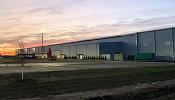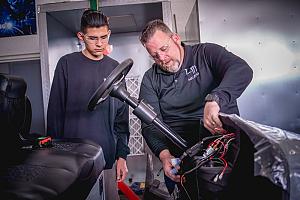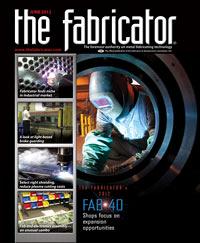Editor-in-Chief
- FMA
- The Fabricator
- FABTECH
- Canadian Metalworking
Categories
- Additive Manufacturing
- Aluminum Welding
- Arc Welding
- Assembly and Joining
- Automation and Robotics
- Bending and Forming
- Consumables
- Cutting and Weld Prep
- Electric Vehicles
- En Español
- Finishing
- Hydroforming
- Laser Cutting
- Laser Welding
- Machining
- Manufacturing Software
- Materials Handling
- Metals/Materials
- Oxyfuel Cutting
- Plasma Cutting
- Power Tools
- Punching and Other Holemaking
- Roll Forming
- Safety
- Sawing
- Shearing
- Shop Management
- Testing and Measuring
- Tube and Pipe Fabrication
- Tube and Pipe Production
- Waterjet Cutting
Industry Directory
Webcasts
Podcasts
FAB 40
Advertise
Subscribe
Account Login
Search
The FAB 40: It's delivery time
Metal fabricators more concerned about keeping up with business than keeping doors open for business
- By Dan Davis and Tim Heston
- June 13, 2012
- Article
- Shop Management
That’s what The FABRICATOR’s FAB 40 list tells us this year. Only two companies reported projected revenues to be lower than in 2011, and two more expected revenue growth to be flat when compared to last year. That leaves 36 companies doing their best to keep up with increased customer orders.
No. 26–Southern Fabricators Inc.
“A wild journey”
Typically after a recession manufacturing comes roaring back in a big way. While that may not be the case for every metal fabricator, that is exactly what’s happening to Southern Fabricators, Polkton, N.C.
The company’s revenues grew from $9 million to $15 million from 2010 to 2011, and it added 40 employees, increasing the workforce to 130. The company is expecting to top $18 million by the end of this year.
“It’s been exciting,” said Ken Carpenter, Southern Fabricators’ sales manager. “We currently have a skeleton crew on the second shift where we run the large powder coating line, and we have a small welding and fab crew. So we are just touching the tip of the iceberg in terms of capacity, because we are just now starting to use the second shift at all.”
The growth has come from the fabricator’s current diversified customer base. Oftentimes current customers recommend the company to sister divisions. In other instances, nearby OEMs learn about Southern Fabricators’ capabilities and look to strike up a supply chain partnership. Already the company is exchanging information with Caterpillar, which plans to build a 1-million-sq.-ft. plant in Athens, Ga., in the near future.
“Sometimes you think, ‘Wow, how did we get here?’” Carpenter said. “When I came onboard in 1994, our sales were $3 million to $4 million. We thought when we did $6 million that we were rockin’ and rollin’. So it’s been a wild journey.”
Statistics back up that positive feedback. As of March 2012, the U.S. manufacturing sector experienced growth for the 32nd month in a row, according to the Institute for Supply Management. If you were to look more specifically at fabricated metal products, you would see that shipments rose 11.6 percent in the first two months of this year compared to the same period last year.
Capacity utilization rates echo those findings. In the fabricated metal products segment, manufacturers reported an 83 percent capacity utilization rate in March, which was slightly down from the 83.1 percent noted in February but still remarkably higher than the low point of 60.9 percent back in 2009. From a historical standpoint, these current capacity numbers are inching closer to the 85.9 percent rates charted way back in 1994-95.
The FAB 40 can verify the positive manufacturing numbers. As a whole, the 40 companies reported $1.368 billion in revenues in 2011 and project to bring in $1.60 billion by the close of 2012. That’s a healthy 17 percent increase. It also is indicative of the revenue climb that many fabricators have experienced since the Great Recession; the FAB 40 projected a 13.8 percent increase in revenue in 2011 and a smaller 3 percent bump in 2010.
Fabricators have moved on from lamenting the lack of business to lamenting the lack of resources to keep up with business. It’s time to deliver the goods.
No. 22 (tie)—Endicott Precision Inc.
Fabricating locally, shipping globally
Ronald Oliveira has mixed feelings about the dollar’s value among global currencies. The general manager at Endicott, N.Y.-based Endicott Precision said, “I’d rather have our money worth something again.” But on the other hand, “we’ve become a low-cost source country. It has become more economical to buy things here.”
The metal fabricator has clearly benefited from it. For years the 135-person shop has worked with large, local manufacturers that happen to have facilities worldwide. These global companies recognized Endicott as a reliable supplier with excellent quality and on-time delivery rates, and they spread the word. “Our customers are our best salespeople,” Oliveira said.
That word-of-mouth has broadened the contract fabricator’s customer base, both locally and abroad. Between 5 and 10 percent of company revenue comes from customers based overseas—a small amount, but significant for a contract metal fabricator to ship to directly. This spring the fabricator was readying a large shipment headed for a defense contractor in Greece. Other work has shipped to England, Spain, and elsewhere in the eurozone.
Adding Capacity, Not Necessarily Jobs
Last year as we wrote about the FAB 40, the Bureau of Labor Statistics reported the U.S. unemployment rate at 8.8 percent. Today the rate has fallen to 8.1 percent as of April 2012, but that’s not to the liking of many economists who are still waiting for that more traditional large economic bounceback that typically follows a recession.
Manufacturing has made many newfound friends among politicians because the sector is adding jobs, but even manufacturers have been slow to hire. Only seven companies of the FAB 40 stated that they were actively looking to hire new employees. Actually, if you look at the 18 companies that were in both the 2011 and 2012 FAB 40 lists and combined their reported number of employees for each year, you see that they have hired only one more employee. The companies reported 3,432 employees in 2011 and only one additional person this year.
No. 30–Fedtech Inc.
Looking for help
Dave Fox, owner, Fedtech Inc., Mounds View, Minn., wants to add another shift. He just can’t find the workers.
“It seems that everyone has a job. They are pretty happy,” he said.
If the company could beef up its second shift, it could produce more and shorten lead-times to better serve its customers. Fedtech is looking to add staff in the areas of customer service, sales, shipping, and equipment operations.
Even with the struggle to find people interested and willing to take on a career in metal manufacturing, Fox said he remains optimistic. The company forecasts a 13 percent increase in revenues for 2012 when compared to the $13 million it earned last year.
The FAB 40, however, are adding equipment. Nineteen of the companies stated that they are investing in new fabricating tools to help them remain competitive.
Look at No. 12 Cupples’ J&J Co. Inc. of Jackson, Tenn., for instance. After surpassing projected 2011 revenues by 11 percent when it collected $28.5 million, the company again is looking at an increase in revenues to $35 million in 2012. To keep up with the additional business, the fabricator has added two Panasonic robotic welding systems to its lineup of eight robotic welding cells, two Accurpress Edge CNC press brakes, a 6-kw Bystronic BySpeed laser cutting machine, a large CNC turning machine, and its fifth coordinate measuring machine.
“Our approach continues to be one of a balanced attack of machining and fabrication,” Jeff Cupples said.
No. 16–McAlpin Industries Inc.
Continental fabrication
In upstate New York a robotic arm lifts a complex part with curved contours and formed louvers, all features fabricated moments earlier on a state-of-the-art punch/laser combination machine, running unattended throughout the evening.
The next morning workers arrive at a metal fabrication and plastic injection molding plant in Monterrey, Mexico.
These plants aren’t competitors, but collaborators. McAlpin Industries of Rochester, N.Y., has made strides in making its organization globally competitive. In New York it offers engineering services and automated production. But this isn’t McAlpin’s only growth trajectory.
Natural disasters and political upheavals have made dual sourcing a necessity for many, and one such company was looking for a second source for one of its products. Responding to this demand, McAlpin managers met with a Rochester-based plastics company about a year and a half ago, and together they formed a joint venture to open a plant in Monterrey. Although the plant initially was set up to meet the existing customer’s demand, managers now are looking to expand the plant’s customer base.
“It’s another solution we can offer to compete with China,” said Matt McAlpin, vice president of sales and marketing. “It helps us serve customers and other prospects in the region, including through the Southwest.”
Besides buying equipment, the FAB 40 are spending time trying to improve manufacturing processes, hoping to get the most out of their current workforces. Thirteen companies indicated that they were actively involved in lean manufacturing or quality improvement projects.
No. 22 (tie)–CR Metal Products
Are we busy yet?
During the first quarter of this year, workers at CR Metal Products in St. Louis were worried. The shop floor seemed so slow. The work just didn’t seem to be there. At least that’s how it seemed.
“In fact, it was one of the strongest sales quarters we’ve ever had,” said Mark Chadwick, vice president of operations. “Everybody thought we didn’t have enough work. That was because it comes in and goes out.”
The shop now concentrates on flow—specifically, how much time it takes for a metal part to make it through the floor and to the loading dock. The fabricator integrated certain processes into cells: a laser next to several press brakes, a hardware-insertion machine, and perhaps a spot welder, if needed. Parts are routed to certain cells depending on their volume and complexity.
The fabricator has adopted an improvement methodology called quick response manufacturing, which is tailored for the high-mix, low-volume manufacturer. The company has been implementing QRM for about a year now. Before that CR Metal’s shop floor resembled that of the traditional batch-and-queue operation. Work-in-process was everywhere. Today the company has cleared its WIP and filled that space with more equipment. Those machines in turn increased the velocity of parts flowing through the shop, reducing lead-times.
Most significant, Chadwick said, is that the first quarter wasn’t a “heavy material sales quarter.” In other words, it didn’t entail numerous jobs involving automated flat sheet cutting, “when you’re selling more material than [you are] labor. For the first three months, though, we really had a ‘build it’ kind of quarter,” with orders for parts requiring labor-intensive processes like bending, grinding, and welding.
“That’s quite an accomplishment,” he continued. “Now we’re adding more capacity in our cells, so we can be ready to perform a new sales record and still feel like saying, ‘Hey, when is it going to be busy around here?’”
Working Smarter, Moving Forward
The economic lessons of the past five years have been hard-learned, but the FAB 40 companies have taken note. They aren’t going to be overextended financially and weighed down with excessive labor costs. Also, for the most part, they won’t have their financial success linked too closely with just one industry; 38 of the 40 companies (two are linked very closely to the automotive industry) have worked to diversify their customer base over the past few years.
“The goal of diversity in our industry mix has allowed us to capitalize on growing industries and continue to be the supplier of choice, particularly on value-add projects,” one metal fabricator wrote.
The FAB 40 almost overwhelmingly have high hopes for the rest of the year. That likely bodes well for the industry in general.
About the Authors

Dan Davis
2135 Point Blvd.
Elgin, IL 60123
815-227-8281
Dan Davis is editor-in-chief of The Fabricator, the industry's most widely circulated metal fabricating magazine, and its sister publications, The Tube & Pipe Journal and The Welder. He has been with the publications since April 2002.

Tim Heston
Senior Editor
2135 Point Blvd
Elgin, IL 60123
815-381-1314
Tim Heston, The Fabricator's senior editor, has covered the metal fabrication industry since 1998, starting his career at the American Welding Society's Welding Journal. Since then he has covered the full range of metal fabrication processes, from stamping, bending, and cutting to grinding and polishing. He joined The Fabricator's staff in October 2007.
subscribe now

The Fabricator is North America's leading magazine for the metal forming and fabricating industry. The magazine delivers the news, technical articles, and case histories that enable fabricators to do their jobs more efficiently. The Fabricator has served the industry since 1970.
start your free subscription- Stay connected from anywhere

Easily access valuable industry resources now with full access to the digital edition of The Fabricator.

Easily access valuable industry resources now with full access to the digital edition of The Welder.

Easily access valuable industry resources now with full access to the digital edition of The Tube and Pipe Journal.
- Podcasting
- Podcast:
- The Fabricator Podcast
- Published:
- 05/14/2024
- Running Time:
- 62:12
Cameron Adams of Laser Precision, a contract metal fabricator in the Chicago area, joins the podcast to talk...
- Trending Articles
White House considers China tariff increases on materials

A visit to Automate 2024 reveals the future might be now

Why employee-owned companies make sense in manufacturing

Majestic Steel Arkansas fully operational

Rivian to expand Illinois facility to manufacture midsized SUV

- Industry Events
Laser Welding Certificate Course
- May 7 - August 6, 2024
- Farmington Hills, IL
World-Class Roll Forming Workshop
- June 5 - 6, 2024
- Louisville, KY
Advanced Laser Application Workshop
- June 25 - 27, 2024
- Novi, MI
Precision Press Brake Certificate Course
- July 31 - August 1, 2024
- Elgin,




























